The when, what, and how of introducing baby food. Find out the best first foods and what to do at your baby’s first meal to lay the path for healthy eating habits.
This post contains affiliate links for your convenience and any purchases made through those links help to support this site. I only share products I use and like.
Preparing for your baby’s first meal is usually a very exciting and nervous time for parents as you think about introducing baby food. The little babe that has been living on milk and/or formula is about to begin an activity that they will do everyday for the rest of their lives. Along with the anticipation of introducing this new experience to your baby is often the wonder about exactly when, what, and how it should all go down.
Those are good questions to be asking yourself because creating positive eating experiences from the beginning will have a significant impact on their eating habits in the future. Of course, that doesn’t mean there isn’t any room for error, it will be a learning experience for both parents and babies.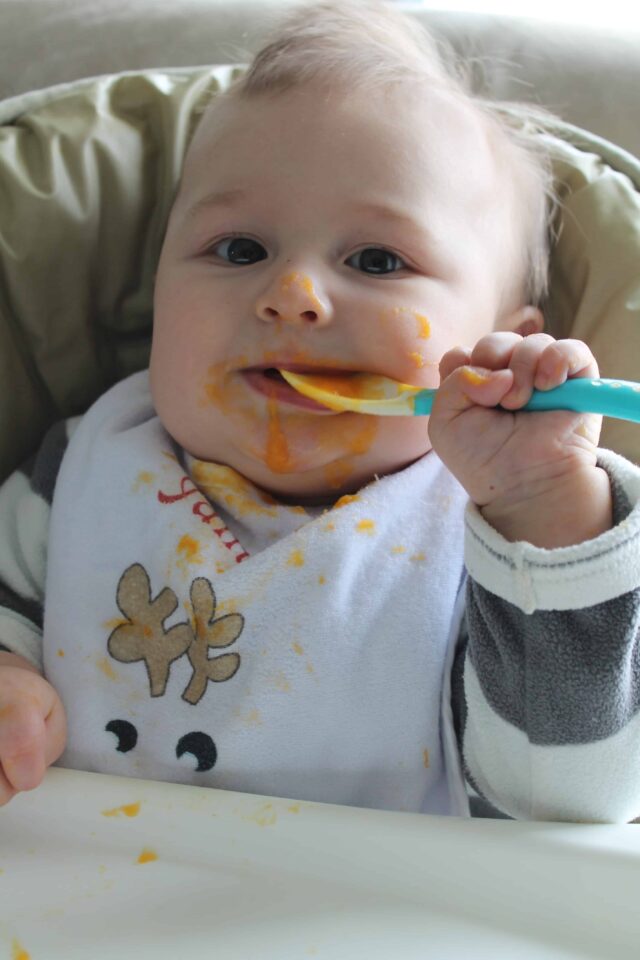
I am just beginning to introduce food to my third child and am surprised to find myself excited about this new milestone again, after all, I have already done this twice before. However, each time I’ve introduced baby food it has been a little different and I have learned more to help me as a Momma and an OT.
If you, too, are on a second, third, or fourth child, there is still value in refreshing your game plan. I want to streamline the wealth of information that is out there on this topic and clear a few things up that often confuse parents. In doing that, I will give you a simple plan that answers the when, what, where, and how from the perspective of a three time mom and pediatric feeding therapist.
At the same time, I always encourage parents to educate themselves and talk to professionals, like your pediatrician, so that you can make the best decision for your baby as you think about starting solid foods.
WHERE SHOULD YOUR BABY EAT?
This may seem obvious, but I wanted to quickly address “where” because occasionally I see things start to go awry here. Always feeding your baby in an upright position seated in a high chair or supportive booster seat is really important primarily for safe swallowing. Having your child sit in a car seat, reclined high chair, or bouncer allows the food to slide right down their throat, often without actively swallowing. This is dangerous because babies can easily cough and aspirate (get food or liquid into their lungs), which is serious business. If your baby is not able to hold themselves upright then they aren’t ready to be eating yet.
I would also strongly encourage you to consistently feed your baby in the kitchen/dining room, around or by the table that you would normally eat. If you don’t typically sit down to eat or mostly eat in front of the TV, now is a good time to change that habit. It will be much easier to start off this way rather than having to backtrack down the line. Setting up this routine will help your baby understand that it is time to eat and that it deserves their full attention (and yours). It sends the message that meal time is a special event. Leave tablets, phones, and toys for outside of meal time. Introducing these things is a slippery slope and you may have difficulty getting your child to eat without them in the future.
Bottom Line: Always feed your baby in a high chair for safe swallowing.
WHEN TO INTRODUCE BABY FOOD FOR BABY?
If you do a quick Google search on the topic of when it is best to feed your baby, you will find conflicting recommendations, which usually leaves parents feeling confused. Most sources now state that 6 months is the ideal time to begin feeding baby solid foods, however, the American Academy of Pediatrics hasn’t changed their previous statement that 4 months is appropriate. Thus, many pediatricians encourage parents to start at this time. I will tell you that most pediatric feeding therapists (myself included) and nutritionists feel strongly that 6 months is better. At this age, food from nutrients are absorbed better, the digestive system is more mature, and babies are able to sit upright with more stability. At the same time, there isn’t a lot of research that shows any ill effects from beginning at 4 months. It is important to keep in mind that once you begin baby food/table food, you are starting the weaning process. While your baby will continue to drink milk/formula as it’s main source of nutrition until the age of one, it will be less once they begin eating food.
If your doctor encourages you to start at 4 months and your feel like you want to wait until 6 months, I would suggest asking them what they feel the benefits are to starting earlier. Always remember that as the parent it is your right to make a choice about what you think is best for your baby. To summarize, at a minimum, your baby should do the following before introducing food:
- Sits up with little or no assistance.
- Shows an interest in food, by looking at what you’re eating or reaching for food.
- Is at least 4 month of age.
Bottom Line: Start feeding your baby around 4-6 months when you as the parent feel it is time, as long as your baby is able to hold themselves upright in a highchair and is showing an interest in food.
WHAT ARE THE BEST FIRST FOODS FOR BABY?
Traditionally, rice cereal was suggested as the best first food for your baby because it is very gentle on the stomach. However, research continues to support that fruits, veggies, and even meats are completely appropriate and safe alternate baby foods to begin feeding your baby. In addition, high levels of arsensic have been found in rice which can be dangerous if your baby is eating rice cereal on a daily basis. Other cereals such as oatmeal and mixed grain varieties are safe alternatives.
Although research repeatedly demonstrates that starting out with other foods is safe, many doctors are still recommending baby cereal first. I did introduce rice cereal first with my older two sons, before arsenic levels were reported, but they never really ate daily portions of this. With my third, his first food was butternut squash.
More important than what food you try first, is that you wait four days before trying a new food to check for any possible allergies or intolerance. Allergies doesn’t just mean anaphylactic shock, it also includes rashes, irritability, diarrhea, and/or constipation. By waiting four days, you can weed out which food is causing any possible reaction.
Bottom Line: Feel free to try pureed fruits, veggies, cereals, or meats with your baby first, but wait four days between trying new food to track any possible allergic reactions.
HOW TO GIVE FIRST FOODS TO YOUR BABY
As I already said, you will want to have your baby securely in their high chair. Prior to them eating for the first time, maybe a month or more ahead of time, I like to have the baby sit with us as the table during meals. At this time, I give the baby spoons, large raw carrots, or big pieces of celery to hold, play with, and mouth on. This gives them a chance to explore different textures, decrease their gag reflex, practice feeding them self, and experiment with moving their tongue around in new positions. They should not be able to get any pieces of the food off.
When your baby meets the criteria that I listed above under “WHEN”, begin by having a totally smooth puree of baby food either home made or store bought and place a little bit on a small flat spoon. I like Baby Einstein and The First Years
spoons. While your baby is making eye contact with you, move the spoon toward their mouth. If they reach up to grab the spoon, allow them to help you. If they turn away or break eye contact, wait a minute and try again. Once your baby is looking at you, slowly put the food to their mouth. Ideally, they are going to open their mouth, in which case, you will put a small amount on the front of the tongue and let the baby mouth it off. Do not scrape the food off using their gums. If they don’t open their mouth, demonstrate by opening your mouth and then touch the tip of the spoon to their mouth. Give a smile and “yay” or some type of praise so they know this is what you want them to do. You can learn more about spoon feeding the right way here.
It is not important for them to consume a certain amount at any point, but especially early on. This is a brand new experience that will take them some time to be accustomed to. As adults, we often take for granted how new this all is. Let this first experience be whatever is, no expectations or goals. In most cases, your baby will only eat a few bites, and that is great. One thing you can focus on is creating a positive, laid back experience. You will feed your baby one to two times a day and slowly increase the thickness of foods over time. Do not add any lumps to the food until they are eating a wide variety of table foods. AND allow them to get messy! I know that is REALLY HARD for a lot of parents, but avoid scraping their face or intervening to avoid a mess. Read more about why here.
Bottom Line: Give your baby a few bites of smooth food from a small flat spoon on the front of their tongue without scraping the food off on their tongue when they open their mouth to accept the food.
For information on how to move to table foods see my posts on transitioning to finger foods. Lastly, if you are thinking about Baby Led Weaning see the pros and cons of BLW.
RED FLAGS TO WATCH FOR
Sometimes feeding your baby doesn’t go as you be expecting it to. While it is important to practice patience, consistency, and keeping a positive environment, sometimes it is helpful to get help. That help can come from your states early intervention program or a feeding therapist (usually an OT or SLP) from a private clinic or local hospital. I recommend seeking additional help if your baby is displaying any of these behaviors:
- Your child is accepting little or no baby food by 8 months old.
- The only way you can get your baby or toddler to eat is by distracting them, such as, feeding them while they walk around, watch tv, or play with an iPAD.
- Your baby refuses to accept any table foods by 11 months.
- Frequent gagging and/or vomiting that prevents them from eating or is due to subtle changes in texture. Get an entire guide to baby gagging that includes tips to overcome it.
Enjoy this exciting time with your baby and talk to your child’s doctor if you are concerned about how they are progressing. Also, be sure to check out Common Mistakes Parents Make to cover all your bases with setting up good eating habits. If you are ready for the next steps in meal time see Feeding Schedule for 6-7 month olds.
Read our toddler feeding schedule.
FOLLOW ALONG
Don’t miss a thing with our newsletter subscription. Plus, get the FREE Printable Guide: How to Improve Eating in 9 Steps! Sign up here!
Did You Pin This???
MORE INFO ON BABIES AND EATING
Feeding Milestones for Babies and Toddlers
How to Wean Your Baby/Toddler From a Bottle
How to Teach Your Baby/Toddler to Drink from a Straw
Benefits of Homemade Baby Food
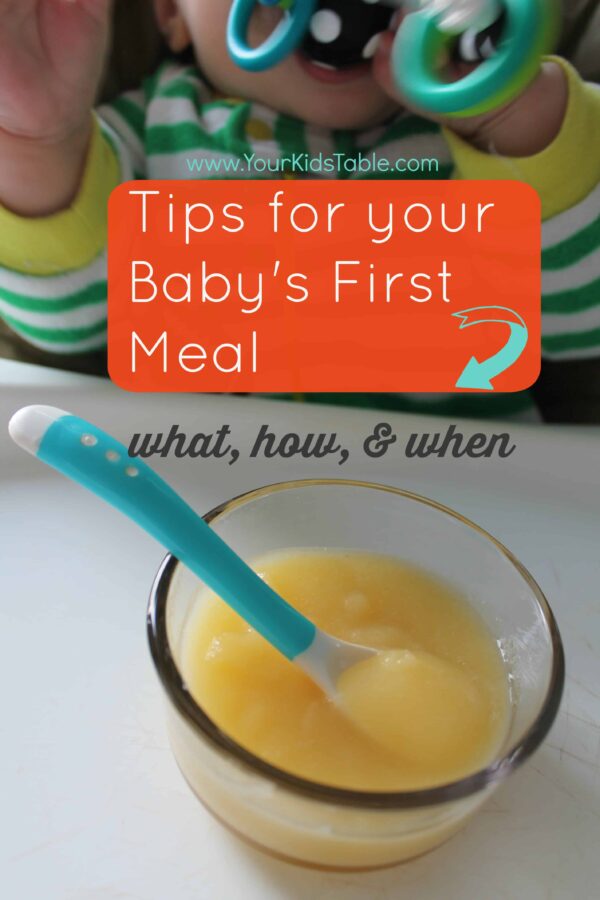
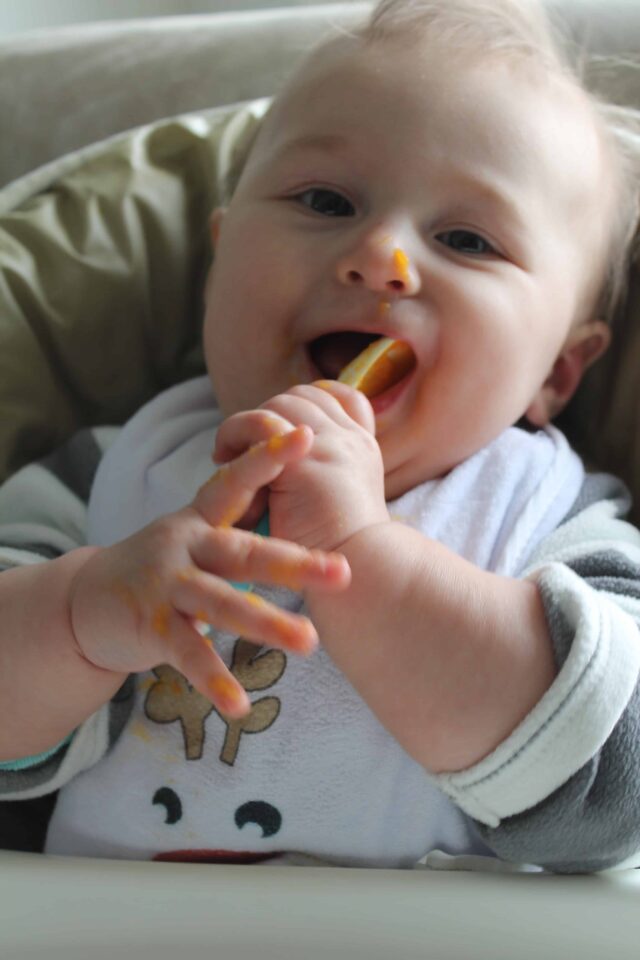
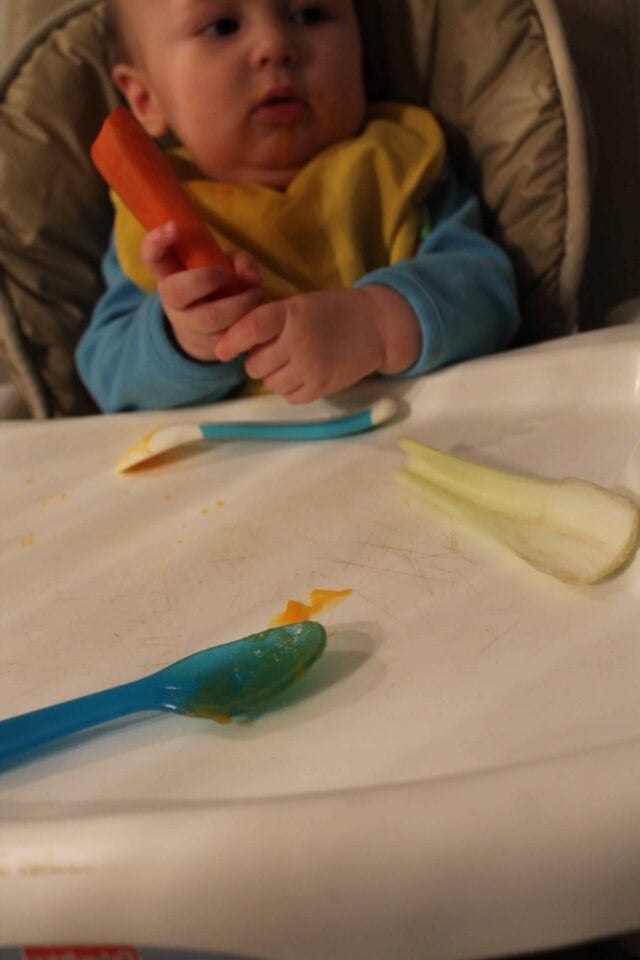
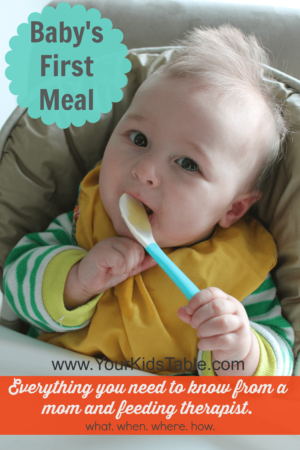
Great article. My 5.5 month old is starting to sit for short spurts unassisted and has taken interest when we are eating. However she does not mouth toys or try to even bring them to her mouth. I’m worried she may not be ready to start at 6 months. Should I wait?
Hi Michelle,
Thanks for reaching out! You can start to gently move her arms while she’s holding a toy to encourage her to start bringing appropriate toys to her mouth. Doing a few tastes at 6 months is a great option, without any big expectations at first. It can be helpful to add a little extra support with small towels around her sides in the highchair if she isn’t sitting for longer spurts as well. HERE is a possible feeding routine for your little one once she turns 6 months. I hope that helps!
Best,
Andrea
Great article but some of your links don’t work anymore like the type of cereal you used or the sheets to track allergies etc.
Hey Marissa,
Thanks for letting us know! We will work on updating those! So glad you enjoyed the article!
Best,
Desiree
Hi my daughter is 1 year 10months,she weighs 8.5kg which is very underweight for her age,she is always gagging or looking the other way when I feed her solids,she doesn’t want to drink formula and I’ve took her to every GP and pediatricians around me and the meds they’ve gave her none of them has helped
If there’s anything you can help me with I’d really appreciate that.thank you
So sorry, you are having trouble feeding your little one, we understand how hard this can be! I’d first be trying to get her engaged with food through play and have a no pressure environment. If she’s not eating any solid foods and is still on purees you can also save your seat for free workshop here. If she is able to chew some solid foods and you’re looking for increasing variety you can save your seat here. Hope you enjoy!
Best,
Desiree
Hi Alisha,my daughter is 7.5 months old and just refuses to eat all kind of baby food,homemade or from the market..when we started at around 6 months she ate baby food one time of each variety and just stopped eating after that .feeding her is a scary task as she cries cries and cries..she wants to eat the solid food on our plate like adults..I tried giving that too but she cuts off small pieces and I’m worried about choking..I don’t know what to do..
Hey Thanks for reaching out! We understand how hard and difficult this can be. I’d first work on trying to get her to play and touch the baby food, as this is a great first step towards eating and positive mealtime experiences. We do also have a free workshop that will help walk you through this process. You can save your seat here
Best,
Desiree
My daughter is 7 months old and never wants to eat her solids. I have tried different flavor foods (homemade with and without milk and store bought), using the spoon, using my finger and letting her just play with the food and she won’t eat them and always turns her head away. I wait a few days to try again cause she never wants any. Should I try using puffs to see if she will eat that or just wait and keep trying solids? Thank you in advance for your help.
Hey Jessica,
Thanks for reaching out! I’d keep offering the purees as it can take some time to get used to them. Make sure she has opportunities to play with the food too! You can also try the puffs to see how she does with them. We do have a free workshop full of great information on transitioning to table foods. You can save your seat HERE
Best,
Desiree
Loads of good information. Thanks.
My LO is 9.5months. We started off with purees at 6m. Very shortly afterwards, she refused purees and was interested in table food. So we switched to blw. Started off great. She ate a few bites only, but seemed to be getting better at the technique of chewing. Less and less gagging. Then she started destroying the food only and throwing them on the floor without trying. Somehow she got frustrated immediately and mealtimes became a struggle. Any softer food she will mash and throw. Got hooked on fruits like watermelon and nectarines (whole-allowed her to bite off of the soft whole fruit). She wants to eat, i can see it on her. She gulps as soon as food is on the table front of us.
Refusing to eat her food (we even offer stuff from our plate with our spoon, which maybe works for one bite) most of the time. Cannot get her to eat more than 2 bites. She eats (gets offered) what we eat most of the time and we try loads of different foods (1st 100 foods challenge)
I am at a loss. It’s been months of the same thing. I don’t know what to do.
Hey Anna,
Thanks for reaching out! It sounds like you are really doing a great job at offering of foods and allowing her to touch them. I’d make sure to continue with that, as well as purees to allow her to get used to textures. We do have a free workshop that is full of great information that can help in where you are in her feeding journey. You can save your seat HERE
Best,
Desiree
My baby was born 2 months early. Do you still recommend starting baby foods at 6 months or wait until he’s closer to 8 months? He sits well and watches us intently as we eat, but beyond that, I’m not sure.
Hey Lindsay,
You said that he sits well, which is a huge sign of readiness 🙂 If you feel comfortable and received the go ahead from your Ped, you can try and see how he does. I’d just have no expectation and see how it goes!
Best,
Desiree
my 8 month old just recently started gagging when trying to bottle feed. As soon as the bottle enters her mouth she gags. She was never breast fed. I’ve even tried giving her water in her bottle and a soppy cup and again she gags. She will ONLY take her bottle when she is extremely hungry and is even hesitant at this time as well. This just started happening out of the blue. So worried she may get dehydrated. We have been to her doctor and they seemed to think i was feeding her way to often and to back off to just offering a bottle 3 times a day but that hasn’t worked. I don’t know what to do! I’ve even tried per her doctor, giving pedialite through a syringe no luck at all!
Hi Tina, Thanks for reaching out as we understand how hard this can be. I’d try to find a bottle with a small nipple as this may help, and also sitting her upright when offering the bottle. We do have an article that I feel will offer you some more support and suggestions. Read more about gagging on the bottle here.
Best,
Desiree
Baby is 6.5 months and HATES baby food. She will seal her mouth shut and will not open. If we do get some in there, she spits it out. Any pointers? Starting to get worried, but our pediatrician (who we love) suggested we not start worrying until closer to 9 months.
Hey Catherine,
We understand that this can be worrisome! She still is on the younger age, however I’d try to be doing some play with pureed foods so that she is touching and interacting with it. This is the first step and she may then start putting her hands in her mouth. We do have a free workshop that addresses this and moving along through food, that you will find some great tips! Save Your Seat Here.
Best,
Desiree
Such a helpful article, thank you! Perfect timing, too, as my son is about 5.5 months and showing lots of interest in food. I’m interested in reading more on why you should not scrape food off of baby’s face but the link doesn’t seem to be working. Do you have another link? Thanks!
I’m glad it was helpful Sarah, thank you for letting me know about the link! I just fixed it. Best of luck!
Great info. I was wondering about when should the baby eat food, before or after breastfeeding? I read two different things. One article said that baby should be breastfed first because it will increase their curiosity to experiment with new foods.
Great question! Baby food should come after, ideally in between feedings. You don’t want baby food to take place of milk or formula right now, as they are very close to one year you will begin to do this, but not yet. If you feed them baby food first they may eat more than they would have and take less milk/formula.